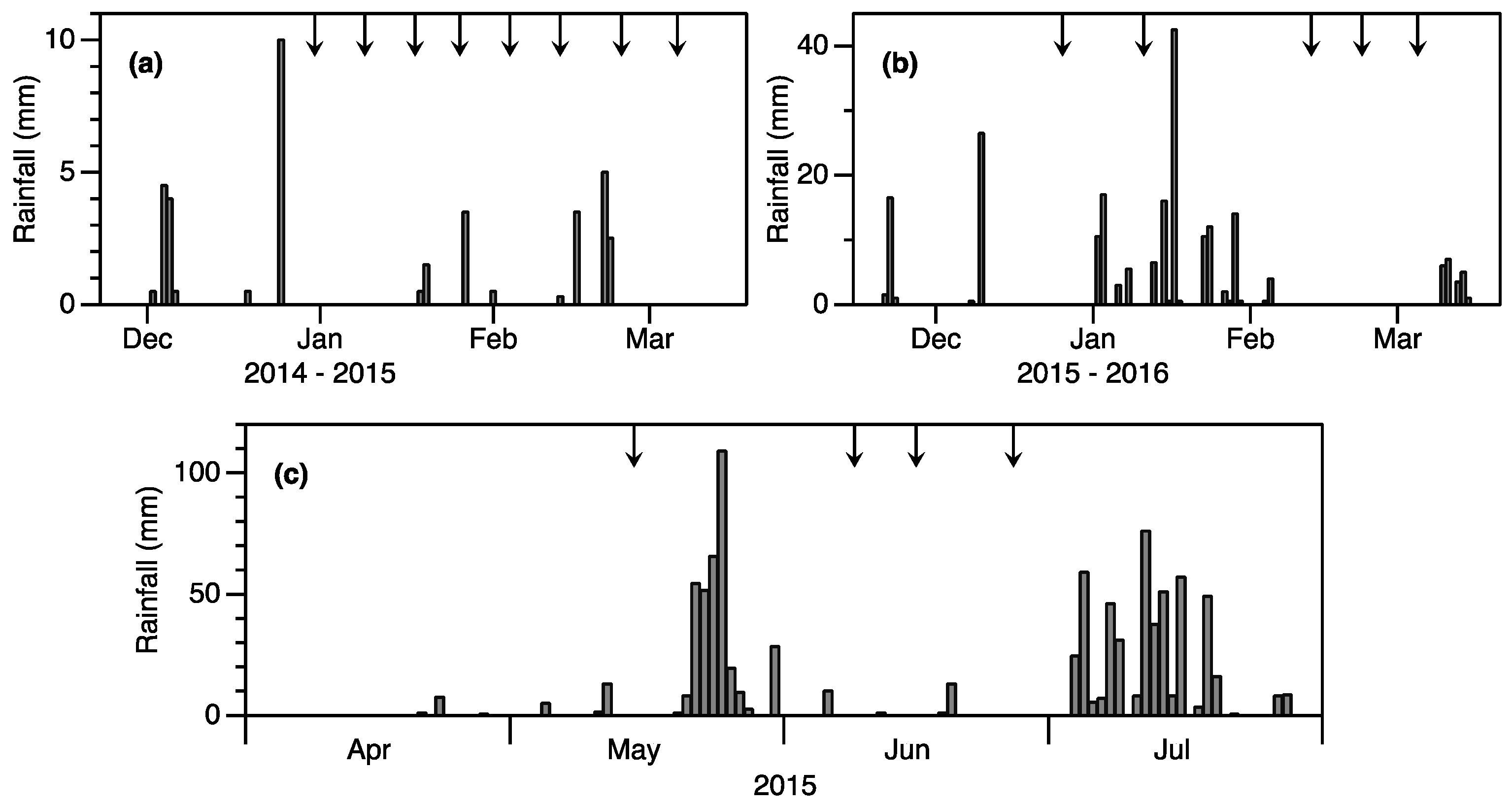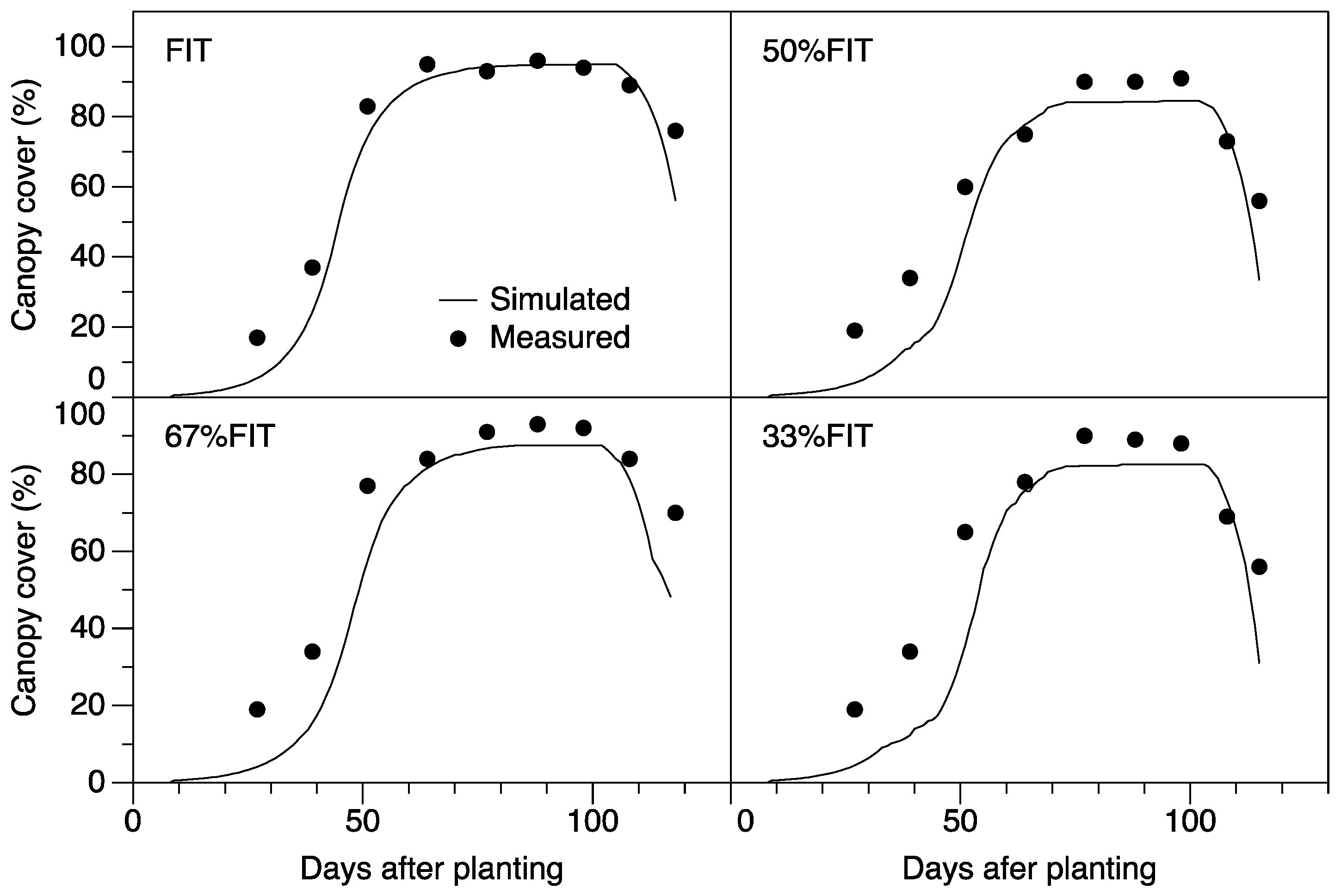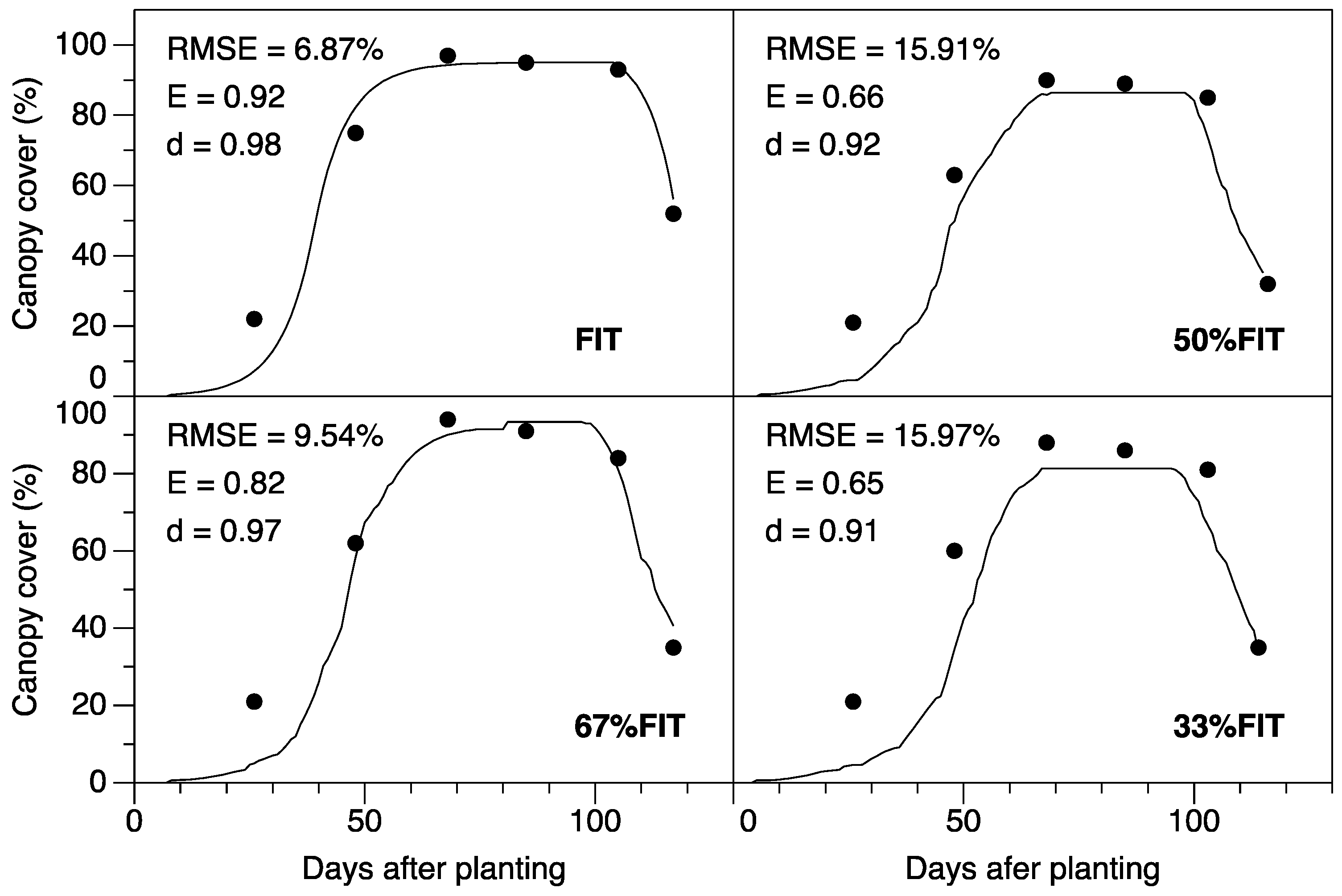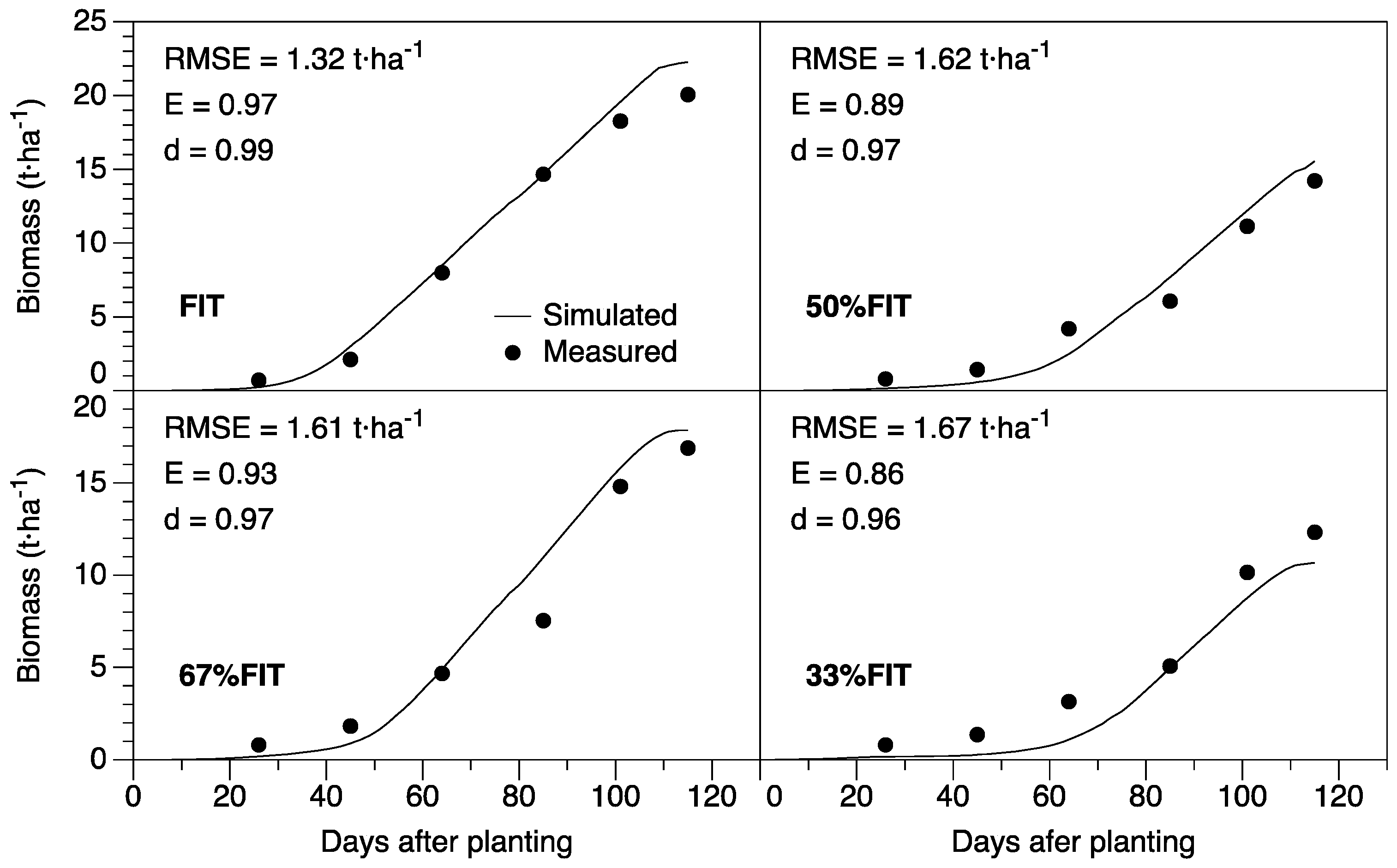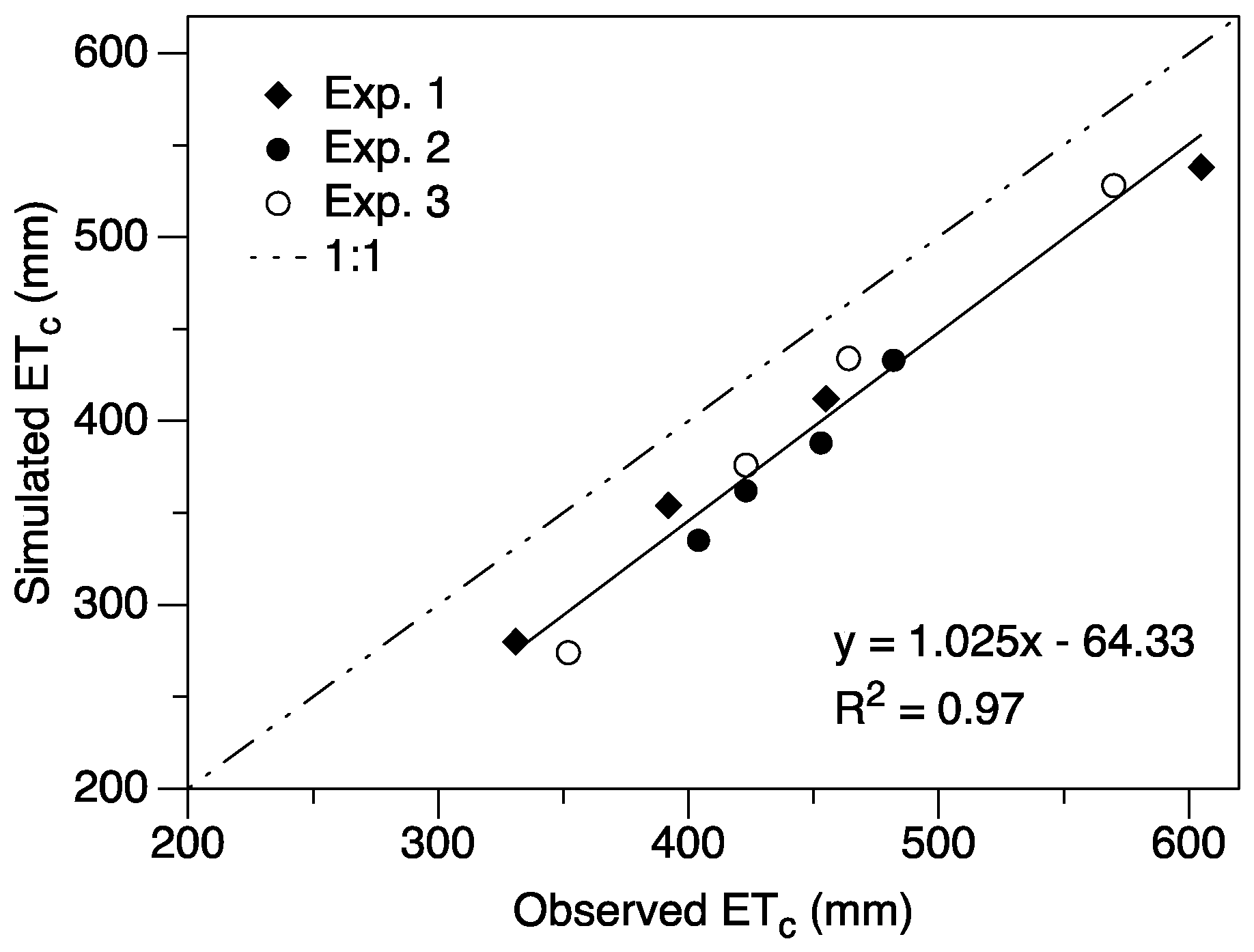1. Introduction
Population growth, land use change, climate change, and increasing demand in non-agricultural sectors profoundly affect the availability and quality of water resources for irrigated agriculture. Amid increasing concerns that water scarcity and food security are among the main problems to be faced by many societies in the 21st century, a global challenge for the agricultural sector is to produce more food with less water [
1]. Irrigation strategies focusing on increasing agricultural water productivity, such as deficit irrigation (DI) coupled with crop simulation modeling to investigate multiple alternatives, have a pivotal role to play in sustainable water development.
Extensive research and publications highlight the contribution DI management strategy makes in combating water waste in irrigation. By providing less than the exact crop water requirements, specifically during drought-tolerant growth stages, crop yields can be stabilized and maximum water use efficiency (
WUE) attained [
2]. Judicious planning is therefore required as supplying crops with less than their water requirement can significantly affect crop growth and development, inevitably affecting yield, especially if water stress occurs during the susceptible growth stage. DI is a flexible management strategy and its successful implementation is dependent on a sound irrigation schedule, in terms of both timing and application amount. Therefore, there exist numerous possibilities when investigating and imposing a DI management plan. Some of these include growth-stage-specific DI, intermittent DI (irrigation is applied on specific days), and root zone soil moisture depletion. In each case, different water amounts can be applied. Owing to their cost and time effectiveness, crop simulation models are ideally suited for the evaluation of irrigation strategies where there are various alternatives.
The FAO AquaCrop simulation model provides a sound theoretical framework to investigate crop yield response to environmental stress [
3]. This model has successfully simulated crop growth and yield as influenced by varying soil moisture environments for crops like sunflower [
4], bambara groundnut [
5], and winter wheat [
6]. Farahani et al. [
3] and Geerts et al. [
7] suggest that this model maintains a good balance between robustness and accuracy, and a noteworthy feature of the model compared to other cereal crop growth models is the simplicity it offers its users; it does not require advanced skill for its calibration or operation and does not require a large number of input parameters [
8]. The relatively small number of input data describes the soil–crop–atmosphere environment in which the crop develops, most of which can be derived by simple methods. AquaCrop simulates crop growth and yield based on the water-driven growth model that relies on the conservative behavior of biomass per unit transpiration relationship [
4,
9]. This fundamental principle contributed to the simplistic structure of the model, having a greater applicability in space and time, as the model features “conservative input parameters” that transcend geographical location and cultivar [
9,
10]. Raes et al. [
11] noted that these conservative parameters require no adjustment to the localized environments, favorable or limiting conditions, as their modulation is triggered by stress response functions.
AquaCrop yield response model has been applied to a wide range of crops including maize. Heng et al. [
8] and Hsiao et al. [
12] reported that AquaCrop simulated maize development, grain yield, and water variables such as the crop evapotranspiration (
ETc) and
WUE, to name a few, reasonably well in cases of non-limiting conditions. Still, some studies report that model performance declines in estimating some variables in severe water stress environments [
1,
13]. Although a highlighted feature of the model is the applicability of conservative parameters used in crop simulations (these parameters are reported by Heng et al. [
8] and Hsiao et al. [
12] for maize), several researchers observed that model parameterization is essentially site-specific and that important calibrated parameters necessary for accurate simulation must be tested under different climate, soil, cultivars, irrigation methods, and field management to improve the reliability of the simulated results [
3,
14,
15].
Owing to the diversification of its uses, maize is a cereal crop that significantly contributes to a country’s self-sufficiency. Taiwan has recorded a considerable decrease in maize production and now relies heavily on imports from the international market to meet demand [
16]; the average cultivated area of maize in Taiwan is approximately 18,000 ha/year (2005–2009 estimate) from about 90,000 ha/year in 1980–1990 [
17]. Amid a water-intensive rice industry (Taiwan’s main crop), the successful revival and planned expansion of maize production requires sustainable water management strategies, especially considering that dry spells are a characteristic feature of the main cropping season. The availability of a model adapted to local conditions should have a strong impact on planned expansions and would aid in assessing competing management alternatives and possible constraints. Integrating crop models that simulate the effects of water on crop yield with targeted experimentation can facilitate the development of irrigation strategies for high yield procurement and improving farm level water management and
WUE.
The objectives of this research were two-fold: (1) To analyze the performance of AquaCrop for maize under full and deficit irrigation in the tropical environment of Southern Taiwan; and (2) to test and validate the effectiveness of the calibrated model in simulating biomass yield and grain yield under contrasting environmental conditions.
4. Discussion
One noteworthy feature of the FAO AquaCrop model is the use of proposed “conservative parameters”. That is, a set of nearly constant parameters that do not change materially with time and management practices, are presumably applicable to widely different environmental conditions and climate, and are not specific to a given crop cultivar [
11]. In this study, an iterative process was used to test the conservative parameters proposed by Heng et al. [
8] and Hsiao et al. [
12] for maize. In general, these parameters worked well in simulating crop growth, as evidenced by the unchanged values given in
Table 3. However, in the severely stressed treatment (33% FIT) there was some mismatch between the model prediction and the observed values of daily
B and
CC, perhaps indicating that a change of these values, specifically stress threshold values, would improve the model simulation. Since the aim of the model calibration was to test for values that can work adequately under all conditions, the proposed values were maintained for use in predicting crop development and productivity as they worked well in non-stressed and moderately stressed conditions. Statistical indicators of
RMSE,
E, and
d observed during the calibration process confirm this (
Table 4). During the validation exercise it was observed that the performance of the AquaCrop depends on the water stress level experienced by the plants during the crop cycle and the output variable.
During the validation test, the seasonal evolution of
CC was underestimated while the biomass was generally overestimated, except for the severely stressed treatment (33% FIT), where it was underestimated. Furthermore, the deviation between observed and simulated daily
CC and biomass was more pronounced under water deficit conditions, becoming more intense as stress levels increased. The larger deviation between observed and simulated
CC under water deficit and stress environments has also been reported for other crops like potatoes [
15]. The general tendency of AquaCrop simulation model to overestimate maize biomass under water deficit conditions has been reported by Heng et al. [
8], who contribute the deviation to vegetative stress and suggest that this can be attributed to the actual stomatal conductance being less than that simulated. Under the more severely stressed treatment of 33% FIT (
Figure 6), the model underestimated the biomass through the whole season, which suggests that the model was not able to simulate the temporary relief from soil moisture stress due to irrigation application, unlike the other deficit treatments. For the other water deficit treatments of 67% FIT and 50% FIT, there was an initial underestimation of biomass up to about 60 DAP before overestimation. Observations made regarding a general whole-season underestimation of biomass for the more severely stressed treatment (33% FIT) was analogous to that reported by Katerji et al. [
13] for maize and by Jin et al. [
29] for winter wheat.
Simulated grain yields from Experiment 1 and 2 used in the validation exercise reduced on average by 19% for 67% FIT, 25% for 50% FIT, and 37% for 33% FIT with respect to the yield simulated under full irrigation. In comparison, measured yield reduction from the FIT was 11%, 21%, and 33% for 67% FIT, 50% FIT, and 33% FIT, respectively. The range of yield reduction for both measured and simulated data is similar to those reported by Katerji et al. [
13] and García-Vila and Fereres [
30]. These results imply that AquaCrop adequately predicts grain yield under varying environmental conditions, although the accuracy of the model declines in severely stressed conditions, confirming conclusions drawn from the two previously mentioned research. Furthermore, Katerji et al. [
13] observed that in cases of severe moisture stress (based on a pre-dawn leaf water potential of −1.2 MPa), AquaCrop is unable to predict corn grain yield. Higher final biomass and grain yield were observed for maize sown in April (Experiment 2,
Table 2). Two factors can account for this. First, for this season the soil moisture environment was better, reducing the length of the soil drought cycle on account of the rainfall. Rainfall would have had a significant impact on the experiment, as seen seeb by the four irrigation management applications, compared to the other seasons where irrigation application would have been the driving force behind the soil moisture environment. Secondly, during this cropping season the higher growing degree days would have promoted canopy growth and biomass accumulation, specifically during early developmental stages. According to Farahani et al. [
3] and Jin et al. [
29], the development of
CC affects the rate of transpiration and consequently biomass and grain accumulation. Further studies manipulating the planting dates during the two distinct cropping seasons would be valuable.
AquaCrop model was also tested for its ability to simulate seasonal
ETc and the
WUE under different irrigation scenarios. Similar to the observations of Katerji et al. [
13], AquaCrop systematically underestimated the seasonal
ET and the deviations generally increased as stress levels intensified (
Table 6). The range in reduction of 6.47% to 22.16% between simulated
ETc compared to observed values is higher than that reported by Heng et al. [
8] during the validation of AquaCrop for maize, but less than the range of 5% to 37% for maize grown in varying levels of soil moisture stress observed by Katerji et al. [
13]. In addition, the range calculated is similar for other crops grown in water deficit conditions like cotton [
3] and tomato [
31]. Large discrepancies between most values (8 out of 12 cases >10% deviation) can perhaps be attributed to the excessive drainage simulated by the model that was not observed in field measurements. Spatial variability of the soil could contribute to the discrepancy between observed and simulated results. Assumptions of uniform distribution of water in model simulations will inevitably lead to considerable differences in results of soil moisture content. In evaluating AquaCrop’s ability to simulate soil water content for pearl millet under irrigation and rainfed conditions, Bello and Walker [
32] concluded that the model performance is moderate but needs considerable improvement. Further, simulated
ET in AquaCrop is computed from the combination of soil evaporation and crop transpiration, which provokes some debate about the reliability. Katerji et al. [
13] noted that while the measured
ET values mainly reflect transpiration losses, simulated
ET corresponds uniquely to soil evaporation, resulting in AquaCrop typically simulating low values of daily
ET and overestimating the drought effect on this variable. Likewise, Farahani et al. [
3] report that model estimation of soil evaporation is questionable because of the narrow range of soil evaporation observed across irrigation regimes, with large differences in application amount. Altering the conservative parameters used to directly simulate soil evaporation and crop transpiration like water extraction pattern, crop transpiration coefficient, and decline of crop coefficient was observed to have only a small change (low sensitivity level) on the simulated transpiration values. Thus, in most cases the defaulted values were maintained (
Table 3). A low sensitivity level parameter indicates that the model response to change in input is generally less than 2% [
7,
24]. Geerts et al. [
7] and Salemi et al. [
24] reported similar observations for some of the abovementioned parameters.
Owing to some significant mismatch between simulated and observed
ETc values, the deviation between actual and simulated
WUE of grain yield was large for most treatments (
Table 6). However, the simulated values of
WUE were similar to values reported in other studies for maize in varying soil moisture environments [
8]. The large deviation of AquaCrop simulated
WUE from field-estimated values has also been reported in other studies [
4]. These authors report a deviation of up to 27% and 44% for sunflower grown under deficit irrigated and rainfed conditions, respectively, and a relatively low
R2 value (0.43) for the regression analysis of simulated
WUE versus measured
WUE. The large deviations observed in the study imply that there is considerable room for improvement in the model estimation of
WUE, which relies heavily on predictions of crop
ET. Evett and Tolk [
28] suggest that AquaCrop only reliably simulates
WUE under well-watered conditions but tended to misestimate
WUE under conditions of water stress. Katerji et al. [
13] further emphasize that AquaCrop’s performance in predicting
WUE is especially unsatisfactory in cases of severe moisture stress.
The preceding discussion presented the response and resulting effectiveness of AquaCrop simulation model to different soil moisture environments. However, comparing the results between the two distinct cropping seasons used in the validation process (Experiments 1 and 2) presents another outlook to explore the efficacy of AquaCrop simulation model. Experiment 1 was subject to lower temperatures and small amounts of rainfall. In stark contrast, Experiment 2 was conducted in environments of higher temperatures, which are much more conducive for maize production, and extremely large amounts of rainfall. Evidently (
Table 5), this resulted in productivity in terms of the biomass accumulation and yield procured being higher for Experiment 2. AquaCrop simulated these agronomic parameters adequately for both seasons, and in fact the relative difference between simulated and measured values was lower for Experiment 2 (
Table 5). This suggests that the model, once properly calibrated, can be reliably used to make predictions of these variables in environments subject to extreme weather variability, and the calibrated model works reasonably well between distinct climate seasons. Furthermore, using the results from this field experiment allows for a more diverse dataset in the validation process. However, the extreme environments highlighted some limitations of the model, particularly its inability to predict
ETc and consequently crop
WUE. For Experiment 2, the relative error (%) between the simulated and measured values for both
ETc and
WUE was generally higher than in Experiment 1 (
Table 6). This implies that the model reliability for these water variables decreases when challenged by extreme weather variations such as intense rainfall events and therefore reveals room for improving the model.
